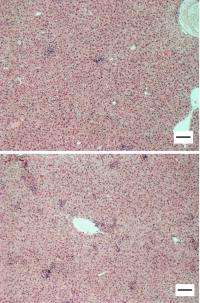A central regulator of the inflammatory response shows signs as a target for therapies against autoimmune disease

Some bacterial infections trigger the formation of structures known as granulomas, which essentially quarantine compromised cells. “Infected macrophages get surrounded by other immune cells, such as T cells and neutrophils,” explains Takashi Tanaka of the RIKEN Research Center for Allergy and Immunology in Yokohama. “This serves to wall off pathogens that resist destruction and limits their infection within a restricted area.”
This response is generally beneficial but can lead to a harmful overreaction, especially in patients with autoimmune conditions, where the inflammatory response is not properly regulated. In collaboration with Tadashi Matsuda of Hokkaido University, Tanaka’s group has now revealed a key regulatory checkpoint in the granuloma formation process, which might ultimately inform the development of more effective immunomodulatory drugs.
Historically, a subset of the immune system’s helper T cells, called TH1 cells, has been associated with autoimmunity. Previous research by Tanaka demonstrated that a protein called PDLIM helps restrict production of these cells2. More recently, other researchers identified a population of helper T cells called TH17 cells that also contribute to this process, although their role was unclear, so Tanaka sought to determine whether PDLIM2 regulates these cells as well.
His team found that mice lacking the gene encoding PDLIM2 formed many more granulomas in response to infection with Propionibacterium acnes bacteria (Fig. 1), and that this process was dependent on the action of TH17 cells. In fact, the researchers showed that PDLIM2 directly inhibits the differentiation of CD4+ T cells into TH17 cells, as was previously demonstrated with TH1 development. This protein works by marking other proteins for rapid degradation. Tanaka and colleagues learned that PDLIM2 specifically promotes the destruction of STAT3, a signaling protein that switches on genes responsible for TH17 development. Without PDLIM2 constraining the formation of these pro-inflammatory cells, the immune response has the potential to spiral out of control.
This protein therefore appears to be a key safeguard against autoimmunity. “Recent studies suggest that TH1 and TH17 cell subsets are not mutually exclusive, but cooperatively induce inflammatory responses,” says Tanaka. “Our work demonstrates that PDLIM2 can negatively regulate the development of both cells, and thus represents a useful new target for the treatment of human autoimmune and inflammatory diseases.” Tanaka and colleagues now hope to better understand this protein’s function by clarifying the regulatory factors that act upstream and downstream of PDLIM2, and by clarifying how this system influences other inflammatory processes, such as those observed in cases of asthma or during wound healing.
More information: Tanaka, T., et al. PDLIM2 inhibits T helper 17 cell development and granulomatous inflammation through degradation of STAT3. Science Signaling 4, ra85 (2011).
Tanaka, T., et al. SLIM is a nuclear ubiquitin E3 ligase that negatively regulates STAT signaling. Immunity 22, 729-736 (2005).
















